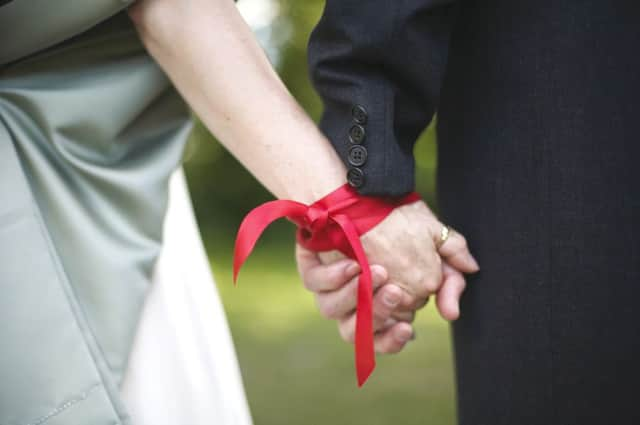Forget me knot: The Scottish wedding customs we can’t leave behind


While that is also true of Scottish weddings, brides north of the Border can be given something of a run for their wedding budget money by their grooms.
A kilt is traditional and it seems that while many fashions come and go, Highland dress on your wedding day is still the most popular attire for the groom and groomsmen in Scotland. Sporting the clan tartan with matching flashes, a white shirt and kilt jacket of your choice with a waistcoat, wool socks and tie is the norm.
Advertisement
Hide AdAdvertisement
Hide AdAdded to that is the sporran, kilt pin, cufflinks and a sgian dubh, so in all a Scottish groom’s ensemble can easily rival the value of his bride’s.
An older Caledonian tradition is for the bride to make the groom’s wedding shirt and for the groom to buy the bride’s wedding dress.
And while in many countries brides are advised to wear something old, something new, something borrowed and something blue, the rhyme has another line: “And in Scotland, a sixpence in her shoe”, which represents good fortune and prosperity for the new couple.
It is also seen as good luck for the bride to have white heather hidden in her bouquet and to wear a luckenbooth, a brooch either passed down from the mother’s family or given by the groom as a love token before the wedding.
It is usually made of silver, engraved with two intertwined hearts and topped with a crown to represent Mary Queen of Scots.
One older tradition which isn’t commonly practiced now, perhaps understandably, is for the bride to have her feet washed. Once upon a time, happily married women would wash and dry the bride’s feet on the morning of her wedding, but these days even the most traditional bride might baulk at requesting this task.
Another custom concerning the bride’s feet is easily accomplished, however. Right foot forward is the correct procedure a bride should follow when exiting her house on her way to the wedding.
With humanist ceremonies becoming more popular, a great many of these older wedding practices are being revived. Couples are keen to create a versatile ceremony, adding in whatever traditions they like.
Advertisement
Hide AdAdvertisement
Hide AdHandfasting is becoming a big trend and involves a ceremony of tying the wedding couple’s hands with cloth or tartan to symbolise the joining of the couple, and their families. It is a very old practice, which gave rise to the phrase “tying the knot”, and can be a very moving part of the marriage ceremony.
Equally, the age-old custom of drinking from a quaich is becoming popular again. The two-handled shallow cup is filled with whisky and drinking from it symbolises the trust and bond between the couple. The quaich can then be passed around the family to allow them to toast the union in an act of fellowship.
Food was never a big part of weddings in Scotland. Normally the family would all make and bring a dish for everyone to help themselves.
It was known as a penny wedding and following this arrangement today would make for a very economical reception. But even if there is a formal meal after the ceremony, the traditional wedding dish of stovies can be served to guests at the end of the evening for a distinctly Scottish flavour.
But at the beginning of the proceedings, the Wedding Walk is the formal march taken by the marriage party to the church.
Preceded by a piper or fiddler, the bridegroom leads the maid of honour while the bride walks behind with the best man. After the ceremony, the newlyweds leave the church followed by the best man escorted by the maid of honour. To secure good luck it was traditionally thought that the wedding procession should cross running water twice.
The Traditional Grand March is often the first dance to take place at the reception. It begins with the bride and groom marching out to the sound of bagpipes or a live band. The chief bridesmaid and the best man join in, followed by both sets of in-laws, and finally the guests.
The Lang Reel is a traditional dance which comes from fishing communities around Scotland. This sees villagers and the wedding party begin at the harbour and continue reeling through the village, with each couple leaving the dance when they pass their home.
Advertisement
Hide AdAdvertisement
Hide AdIt might be logistically impossible to dance everyone home these days, but an Orcadian Strip the Willow, with long lines of guests spinning to the music, is a fine little nod to tradition to round off the big day.